Types of Palm Fronds: Identification Guide With Pictures

Palm fronds are the foliage or leaves of palm trees. The most common types of palm fronds are fan-shaped and feather fronds. However, some rare palm tree types have bipinnate fronds resembling fishtails. Other palms have fronds called entire leaves. These lack the characteristic slender, pointed leaflets of common palm tree fronds.
For example, the fishtail palm (Caryota mitis) has long arching fronds with narrowly triangular or deltoid leaflets resembling a fish’s tail. These leaflets grow on stems measuring 6 to 10 ft. (1.8 – 3 m) long.
Which palm trees have fronds classified as entire leaves? There are five types of palms with entire leaf structures. One of the most stunning is the spectacular Silver-Joey palm (Johannesteijsmannia magnifica). The palm leaves grow out of the ground and measure up to 10 ft. (3 m) long and 6 ft. (2 m) wide.

The two most common types of fronds are feather fronds (left) and fan-shaped fronds (right)
Evergreen palm fronds are unlike the leaves of deciduous or evergreen trees. Although some trees have leaves similar to palms—pinnate or palmate leaves—palm fronds are typically huge leaves, sometimes measuring several feet long or wide.
What is the Difference Between a Leaf and a frond?
The difference between a leaf and a frond is simple—the leaf structure. A frond can be described as a large, divided leaf found on palms and ferns. Fronds are sometimes called compound leaves because the entire leaf consists of a petiole and several small pointed or rounded leaflets.
Another difference between palm fronds and leaves is their size. Typically, tree leaves are measured in terms of inches or centimeters. However, palm tree leaves are so huge that they are measured in terms of feet or meters.
For example, even small palm trees can have 3 or 4 ft. (1 – 1.2 m) long fronds. And palms in the genus Raphia have the largest palm leaves, measuring an enormous 82 ft. (25 m) long.
Types of Palm Fronds (With Pictures) – Identification Guide
Here are the four types of palm fronds.
Feather fronds (Pinnate leaves)
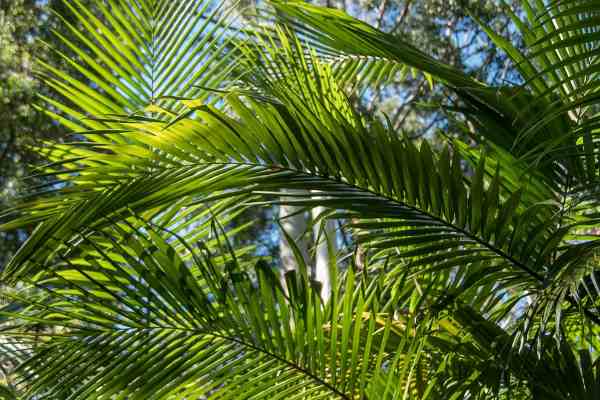
Pinnate leaves (feather fronds)
Feather fronds are pinnate leaves, meaning they have leaflets growing opposite each other along the leaf petiole. The feathery leaves are typically long and arching, with the pinnae (leaflets) drooping down in a graceful growth habit. Examples of palms with feather fronds are queen, coconut, date, royal, and foxtail palms.
Fan fronds (Palmate leaves)

Palmate leaves (fan fronds)
Fan fronds are palmate leaves with stiff, pointed leaflets radiating from a single point. Also called segments, the leaflets are typically joined for most of their length. The space between the segments is called the sinus. The shape of fan fronds is typically almost circular, like an open fan. Examples of palm trees with fan fronds include the Bismarck, European, Chinese, and Mexican palms.
An unusual type of fan frond found on palms in the genus Sabal are costapalmate fan leaves. These rounded palm leaves are a combination of palmate and pinnate leaves. The leaf segments are arranged in a fan shape but attach to a longer part of the petiole, not just a single point.
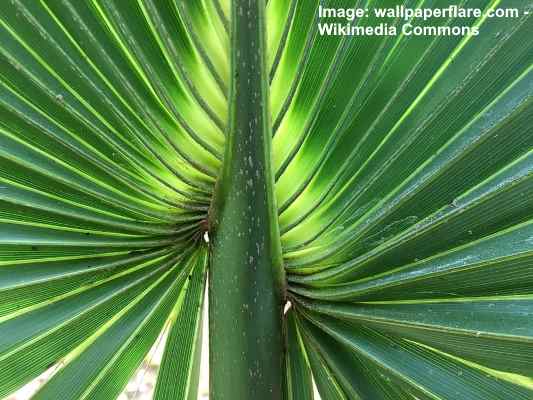
Costapalmate leaves
Bipinnate fronds (Bipinnate leaves)
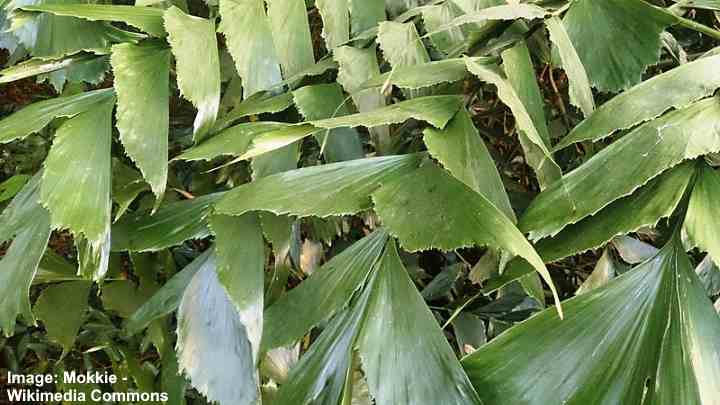
Bipinnate leaves the fishtail palm (Caryota mitis)
Palm trees with bipinnate leaves are relatively rare. These palm fronds have a secondary vein with several leaflets attached to them. In the plant world, common examples of bipinnate leaves are those found on mimosa plants. Palms in the genus Caryota typically have fishtail-like fronds.
Entire fronds
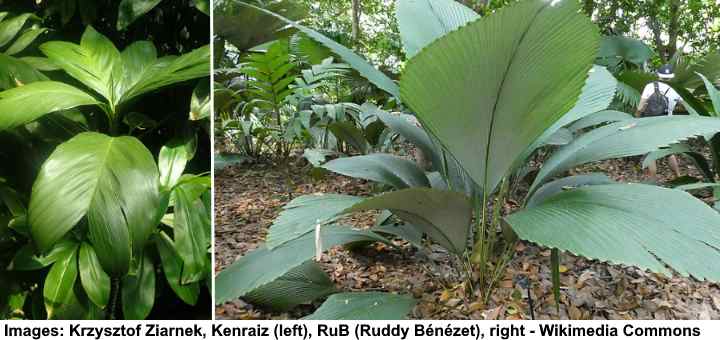
Entire leaves of the necklace palm (Chamaedorea geonomiformis) on the left, and Johannesteijsmannia magnifica (right)
Very few palm trees have entire fronds. These are leaves without multiple leaflets or pinnae growing along the stalk or radiating from a single point on the petiole. Entire fronds resemble leathery leaves from typical trees. An example of a palm with entire fronds is the necklace palm (Chamaedorea geonomiformis).
Types of Palm Trees With Fan Fronds
Let’s look in detail at several types of palm trees that have large, rounded fan fronds.
Mexican Palm Tree (Washingtonia robusta)

The Mexican palm tree is a type of fan palm with a rounded crown of fan-like fronds measuring 3 to 5 ft. (1 – 1.5 m) long. A growth feature of this iconic slender palm tree is the dense skirt below the crown created by dead fronds folding down against the trunk.
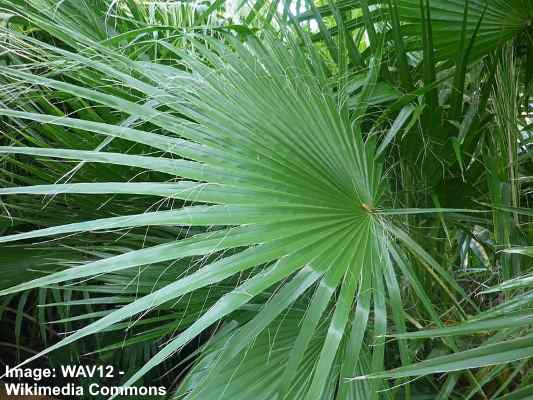
A close up picture of a Mexican palm tree frond
Also known as the skyduster palm, this fast-growing, drought-tolerant tree can grow 40 to 80 ft. (12 – 24 m) tall. It’s a stately palm with a single, slender trunk, large fan fronds, and huge clusters of white flowers followed by small, pea-sized black fruits.
The Mexican fan palm is a common palm tree in southern California.
Bismarck Palm (Bismarckia nobilis)
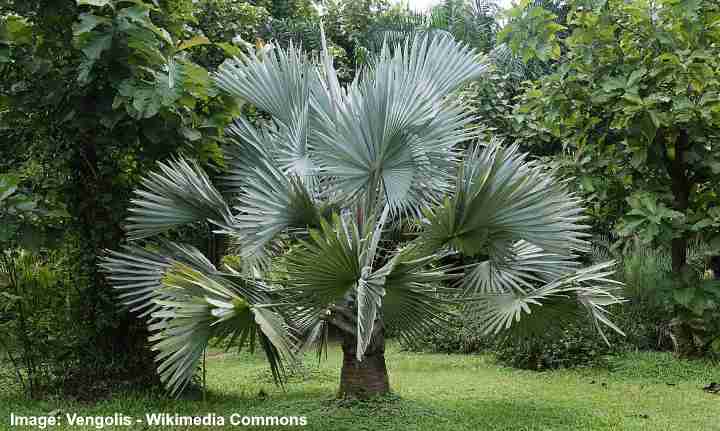
The Bismarck palm tree is one of the most spectacular fan palms due to its massive steely-blue fan-shaped fronds. The eye-catching fronds can measure up to 10 ft. (3 m) wide and have 20 stiff segments joined for most of their length. In addition, the fronds can measure 4 ft. (1.2 m) long.
The Bismarck fan palm doesn’t grow taller than 40 ft. (12 m) tall in gardens. However, the pale silver-blue fronds create an impressive sight when growing in all directions to create a large, spreading, spiky crown.
Real Fan Palm (Hyphaene petersiana)
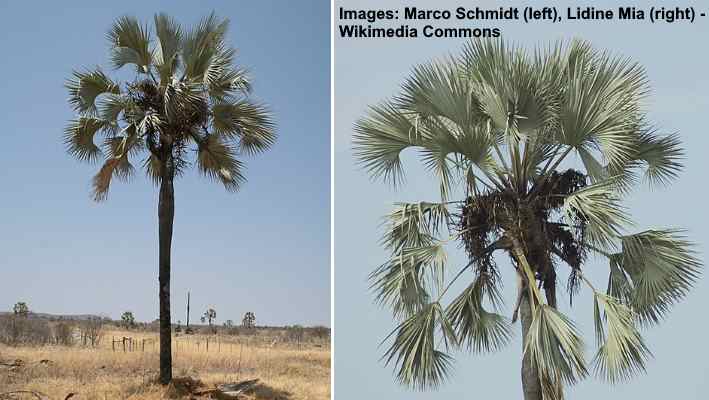
The real fan palm is a large heat-loving palm with huge fan leaves. The palm leaves are gray-green, measure 16 to 22 ft. (5 – 7 m) across, and are at the end of 6.5 ft. (2 m) spiky petioles. The large fan fronds tend to droop in the center, giving them a graceful appearance.
Also called the makalani palm, this fan palm is native to south-central Africa. It has a slender stem growing 32 to 40 ft. (10 – 12 m), topped by a large round canopy of arching fan fronds.
European Fan Palm (Chamaerops humilis)
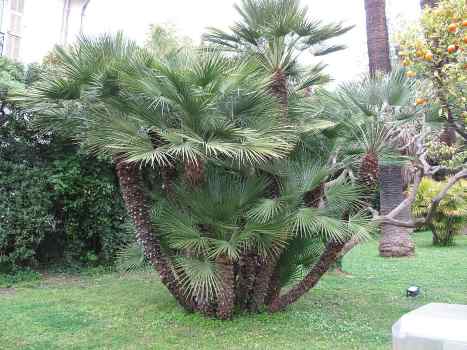
The European fan palm is a dwarf palm tree with a large crown of fan-shaped leaves emerging from spiky stems. Each frond consists of 10 to 20 narrow segments fanning out to an almost circular shape. The fronds grow at the end of 3 to 4 ft. (1 – 1.2 m) stalks.
The European fan palm grows as a large shrub or small tree 6 to 15 ft. (1.8 – 4.5 m) tall. Its multiple stems have a ragged appearance from dead fronds that have dropped. This fan palm is also extremely cold-hardy, withstanding temperatures as low as 10°F (-12°C).
Chinese Fan Palm (Livistona chinensis)
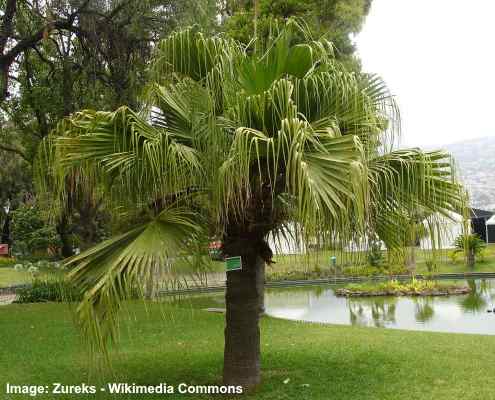
The Chinese fan palm is a type of palm tree with drooping palmate leaves creating a cascading canopy. The identifying features of this fan palm are its emerald green leaves with drooping segments and deep sinuses. The fan leaves measure 3 to 6 ft. (1 – 1.8 m) across.
Also called the Chinese fountain palm, this ornamental tropical palm tree is easy to grow. The palm grows 10 to 30 ft. (3 – 9 m) tall. Other characteristics are its smooth, gray-brown trunk, huge sprays of creamy-white flowers, and large numbers of dark blue palm fruits.
The Chinese fan palm is also a great example of a palm with palmate leaves that grow in containers.
Cabbage Palm (Sabal palmetto)
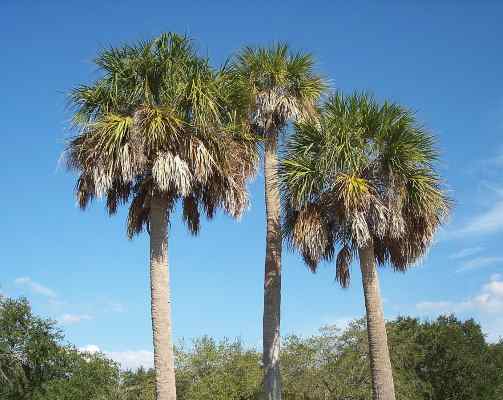
The Cabbage palm is an elegant, single-trunk palm tree with costapalmate leaves. The fan fronds measure up to 6 ft. (1.8 m) long and create a stunning full crown. The unusual feature of the cabbage palm is how the large leaves droop to the gray trunk when they die. This creates a bushy brown skirt-like effect under the green canopy.
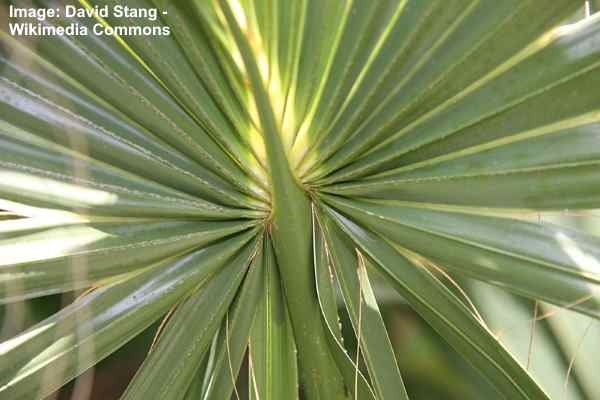
Close up image of sabal palmetto leaf
Also called the cabbage palmetto or blue palmetto, this tropical Florida palm tree grows 40 to 50 ft. (12 – 15 m) tall. The palm tree is the state tree of Florida. Other characteristics of this fan palm include its huge clusters of fragrant white flowers, masses of shiny black fruits, and edible palm hearts used in salads.
The native palm tree is a common sight in the southeastern states along streets, near beaches, and large parks.
Native Hawaii Palms — Loulu (Pritchardia)

Pritchardia remota palm
Palm trees native to Hawaii all have fan-shaped fronds. The palmate leaves on Hawaiian palms are relatively large, typically measuring 3 to 6 ft. (1 – 1.8 m) long. An identifying feature of the leaves of several species of palms in the genus Pritchardia is their drooping growth habit.
Hawaii palms are single-trunked small to medium-sized palm trees with palmate leaves. Depending on the species, the palms grow 20 to 60 ft. (6 – 18m) tall. Typically, native palms in Hawaii grow in mountainous regions, with only two varieties found near coastal areas. Every island in Hawaii has at least one species of native palm.
Blue Latan Palm (Latania loddigesii)

The blue latan palm is a stunning palm tree with striking stiff silvery-blue fan fronds. The attractive segmented leaves of this small palm tree are recognizable by their reddish margins. The huge palmate leaves measure 8 ft. (2.4 m) wide and emerge from petioles 5 ft. (1.5 m) long.
Blue latan palms grow 20 to 25 ft. (6 – 7.5 m) wide. It thrives in hot, dry conditions, where its large spreading canopy of spiky leaves creates ample shade in the sweltering sun. You will often find this palm in seaside locations, planted along driveways, or as an ornamental plant in tropical garden landscapes.
Types of Palm Trees With Feather Fronds
Let’s look in detail at several palm tree varieties with feathery fronds.
Areca Palm (Dypsis lutescens)
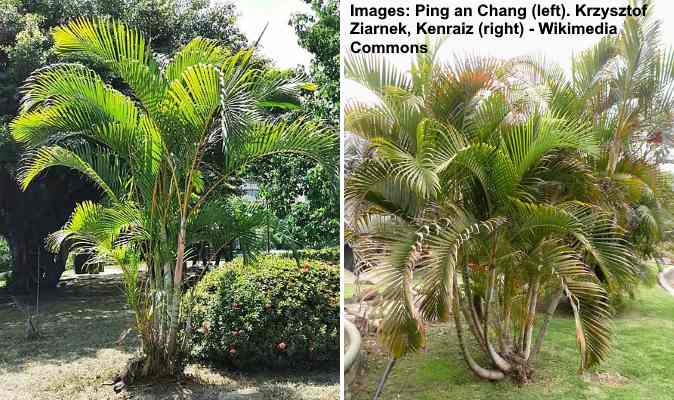
Areca palm is a tropical tree with feathery, pinnate fronds arching gracefully from the trunk. This multi-stemmed feather palm has light green fronds measuring 3 to 6 ft. (1 – 1.8 m) long, growing on bamboo-like canes. Each frond has 40 to 60 lance-shaped leaflets on each side of the stem.
Also called the golden cane palm or bamboo palm, the areca palm grows 12 to 30 ft. (3.6 – 10 m) outdoors. You can grow the palm in tropical zones as a privacy hedge, informal screen, or specimen plant.
The areca palm is also a popular indoor potted palm.
Canary Island Date palm (Phoenix canariensis)
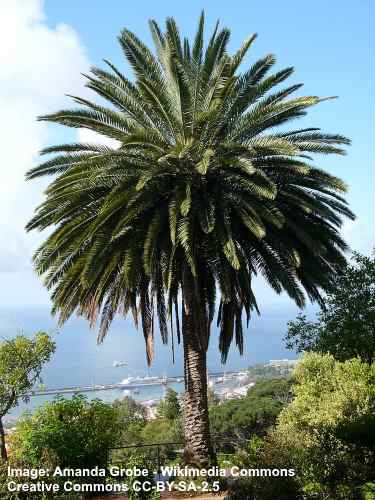
The Canary Island date palm is a large, slow-growing palm tree with a characteristic pineapple-like crown of feathery fronds. The pinnate leaves measure 13 to 20 ft. (4 – 6 m) long and have up to 100 pairs of linear leaflets. In addition, the palm produces clusters of reddish-yellow date-like fruits.
The Canary Island date palm grows 40 to 60 ft. (12 – 18 m) tall. Also called the pineapple palm, the feathery-leafed palm has a columnar trunk with diamond-shaped leaf bases. The Canary Island date palm tree is popular in Florida and other southern states.
Triangle Palm tree (Dypsis decaryi)
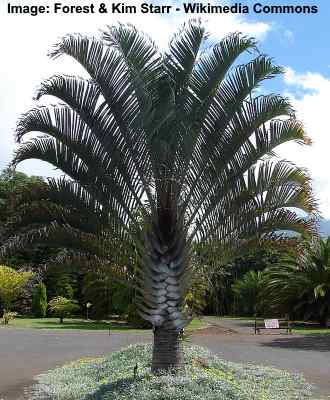
The triangle palm tree is an impressive ornamental palm due to the shape of its feather fronds. The palm leaves have a triangular shape where they are joined at the stem. The leaflets on the arching frond point upward in a V shape. This solitary palm has the appearance of a peacock spreading its feathers.
The unique fronds of the triangle palm are 10 ft. (3 m) long. These are arranged on the palm tree, one on top of another, creating a distinctive triangular shape. The triangle palm grows 20 to 30 ft. (6 – 9 m) tall and 10 to 15 ft. (3 – 4.5 m) wide.
Chilean Wine Palm (Jubaea chilensis)
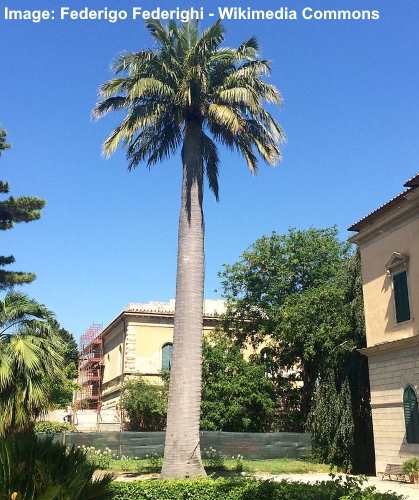
The Chilean wine palm is one of the most impressive palm trees in the world. Its huge columnar trunk is topped with a crown of upward-growing, arching pinnate fronds measuring 15 ft. (4.5 m) long. Under the leaves, clusters of purple and yellow fragrant flowers appear, followed by edible yellow fruits.
The slow-growing Chilean wine palm grows 60 to 80 ft. (18 – 24 m) tall with a crown 25 ft. (8 m) wide. It’s easily recognizable due to its thick trunk—one of the largest of all palms at 3 ft. (1 m) across.
Foxtail Palm (Wodyetia bifurcata)
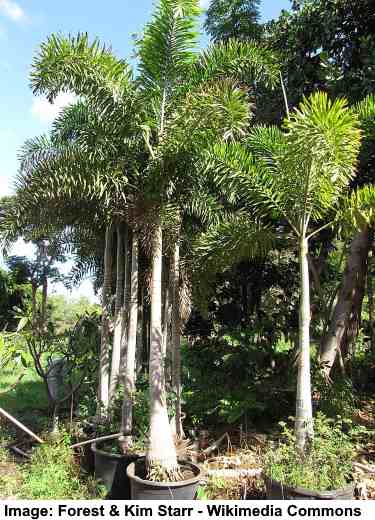
The foxtail palm is easy to identify in a landscape due to its plume-like fronds resembling a fox’s tail. The pinnate leaves measure 6.5 to 10 ft. (2 – 3 m) long, growing at the top of a 32 ft. (10 m) smooth gray trunk.
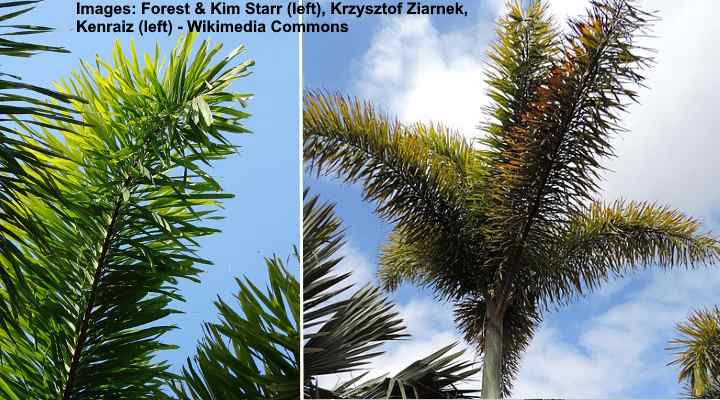
Close up images of foxtail palm fronds
The attractive feature of this sun-loving tropical palm tree is its bushy crown of fronds. Additionally, the palm tree has clusters of dainty white flowers growing at the base of the green crown shaft. After flowering, the palm produces orange-red oval fruits.
Queen Palm (Syagrus romanzoffiana)
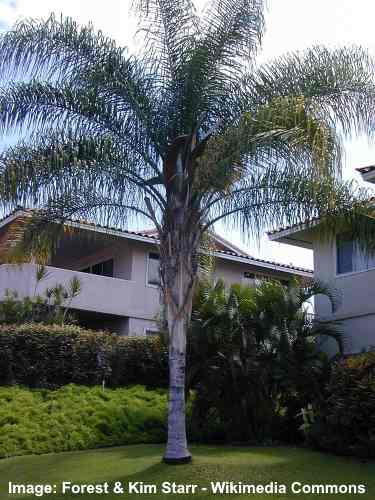
The queen palm is an attractive tropical palm tree with a sparse crown of large, pinnate fronds up to 15 ft. (5 m) long. The arching leaves feature 300 to 500 slender leaflets, giving the graceful fronds a distinctively feathery appearance. These leaves grace the top of a slender, smooth trunk.
The queen palm also features creamy-white flowers growing on 6.5 m (2 m) long branched flower clusters. After flowering, orange or yellow edible dates appear on the tree. Suitable for USDA zones 9 to 11, the queen palm grows tall at 50 to 70 ft. (15 – 21 m).
Caribbean Royal palm (Roystonea oleracea)
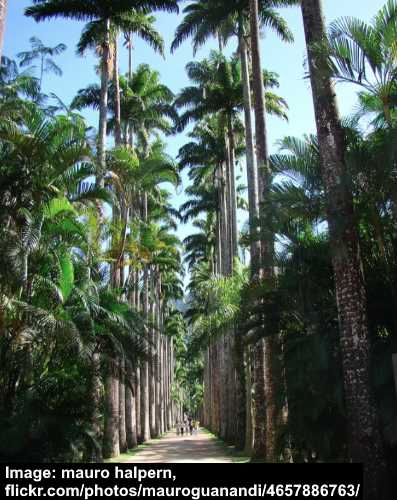
The Caribbean royal palm is a tall tropical tree with feathery palm leaves measuring up to 15 ft. (4.5 m) long. A distinctive feature of this royal palm is its leaflets that attach to the petiole at various angles, giving the fronds a bottlebrush appearance. The tall palm’s crown has around 20 fronds growing from the green crown shaft.
Also known as the imperial palm or the cabbage palm, this majestic and iconic palm tree grows up to 60 to 130 ft. (18 – 40 m) tall. This palm tree is common in tropical landscapes like parks, gardens, and along streets.
Florida Royal Palm (Roystonea regia)
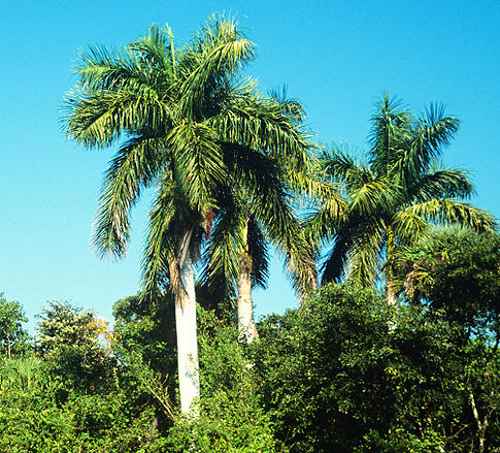
Also called the Cuban royal palm, this native Florida palm tree is a majestic palm with a large dense crown of 15 graceful feathery fronds. The pinnate leaves grow 10 to 15 ft. (3 – 4.5 m) long on top of a bright green crown shaft. It is said that a single frond can weigh as much as 50 lbs. (22 kg).
Identifying features of the Florida royal palm are its columnar gray trunk, distinctive green crown shaft, and bulging base. Additionally, the tropical palm has showy sprays of white flowers that develop into dark red to black palm fruits.
The Florida palm has an upright habit and grows 60 to 100 ft. (18 – 30 m) tall.
Related articles:
